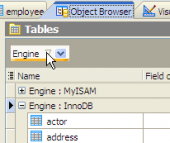SQL Maestro for MySQL online help
| Prev | Return to chapter overview | Next |
Editing properties
The Parameters tab contains the list of the current procedure parameters with its options. Here you can view the Name and the Type of each parameter of the procedure. Use grid's popup menu to add, edit parameters in Parameter Editor. It also allows you to drop and rename procedure parameters.
Parameters can be edited within the Parameter Editor dialog window. In order to open the dialog you should
| • | open the object in its editor and the Parameters tab there; |
| • | select the parameter to edit; |
| • | press the Enter key or select the Edit Parameter item from the popup menu (alternatively, you may use the corresponding link of the Navigation Bar). |
The Definition field contains the definition of the procedure.
Name
Defines the procedure name.
Note: the name of the object must be unique among all the object names in its container. Moreover, all the objects that are source of data need unique names among themselves. You can use any identifier that is allowed by MySQL server.
Owner
There is the owner for the procedure. By default, only the owner of an object can perform various operations with the object. In order to allow other users to operate it, privileges must be granted. (However, users that have the superuser attribute can always access any object.)
Comment
This field contains a comment to the procedure.
Data access (Contains SQL, No SQL, Reads SQL, Modifies SQL)
Use the clause to change the information about the nature of data use by the routine.
Contains SQL - |
indicates that the routine does not contain statements that read or write data. |
No SQL - |
indicates that the routine contains no SQL statements. |
Reads SQL - |
indicates that the routine contains statements that read data, but not statements that write data. |
Modifies SQL - |
indicates that the routine contains statements that may write data. |
Deterministic
Check the option if the procedure always produces the same result for the same input parameters, and uncheck otherwise.
SQL security
Use the characteristic to specify whether the routine should be executed using the permissions of the user who creates the routine or the user who invokes it. The creator or invoker must have permission to access the database with which the routine is associated. It is necessary to have the EXECUTE privilege to be able to execute the routine. The user that must have this privilege is either the definer or invoker, depending on how the SQL security characteristic is set. The clause was added in MySQL 5.1.8.
To apply the changes, select the Apply Changes item in the Navigation bar or use Ctrl+F9 or Ctrl+F7 shortcut keys.
It is also possible to modify object properties without opening the object editor: use the Object Properties item of the popup menu of the selected object from the explorer tree.
| Prev | Return to chapter overview | Next |





 Download
Download Buy
Buy
